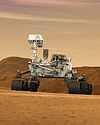Mars-Grunt
| Operator | Russian Federal Space Agency |
|---|---|
| Major contractors |
NPO Lavochkin Russian Space Research Institute |
| Bus | Pereletny Modul or Flagman [1] |
| Mission type | Single launch: orbiter, lander, ascent vehicle, sample return |
| Launch date | proposed: mid 2020s[2] |
| Launch vehicle | Angara-5/Breeze-M |
| Mission highlight | Docking in Mars orbit for a sample return. |
| Mass |
Orbiter: 50kg Lander: 20kg.[3] |
| Power | solar array |
| Orbital elements | |
| Regime | Circular |
| Altitude | 500km[4] |
| Mars landing | |
Mars-Grunt is a robotic spacecraft sample return mission proposed to be sent to Mars in mid-2020s.[5][6][7][8][9] It was proposed to the Russian Federal Space Agency (Roscosmos) by the Russian Space Research Institute.
Lander
If funded by the Russian space agency Roscosmos, it would be developed by the Russian Space Research Institute and NPO Lavochkin, based on Fobos-Grunt technology.[10] Designs show a dome-shaped lander would separate from the orbiter and would enter the Martian atmosphere protected within an inflatable rubber braking cone and fire rockets for the final stage.[11] Once a robotic arm selects and retrieves the samples (mass about 0.2 kilograms (0.44 lb)),[12] a small rocket in the top of the lander would blast the ascent vehicle for rendezvous and docking with the orbiter for the soil sample transfer into the return vehicle.
Cruise stage
The cruise stage PM (from Pereletny Modul) is sometimes referred to as Flagman. It was developed for the Fobos-Grunt mission, but its basic architecture is promised to be the base for a whole generation of future planetary missions, including Luna-Glob, Luna-Resurs and Luna-Grunt to the Moon; Venera-D to Venus; Mars-NET and Mars-Grunt to Mars and, possibly, Sokol-Laplas to Jupiter. The platform's developer - NPO Lavochkin - stressed that in different configuration, the same bus could be adapted as an orbiter or as a lander.[1]
See also
References
- ↑ 1.0 1.1 Phobos-Grunt design
- ↑ Russia takes a two-pronged approach to space exploration April 17, 2012.
- ↑ Roscosmos - Space missions Published by The Space Review (page 9) on 2010
- ↑ Roscosmos - Space missions Published by The Space Review (page 10) on 2010
- ↑ Roscosmos - Space missions Published by The Space Review (p. 8-10, 19) on 2010
- ↑ "Russia takes a two-pronged approach to space exploration". Russia & India Report. April 18, 2012. Retrieved 2012-04-18.
|first1=missing|last1=in Authors list (help) - ↑ "Red Planet Blues". The Space Review. November 28, 2011. Retrieved 2012-04-18.
|first1=missing|last1=in Authors list (help) - ↑ Russia To Study Martian Moons Once Again. Mars Daily July 15, 2008.
- ↑ Major provisions of the Russian Federal Space Program for 2006-2015. "1 spacecraft for Mars research and delivery of Martian soil to the Earth."
- ↑ Phobos-Grunt prepares for launch. ATO - 16 August 2011.
- ↑ Russian Space Probes: Scientific Discoveries and Future Missions. By Brian Harvey, Olga Zakutnyaya. (p 475)
- ↑ Roscosmos - Space missions Published by The Space Review (page 9) on 2010
| |||||||||||||||||||||||||||||||||||||||||||||||||||||
| |||||||||||||||||||||||||||||||||


